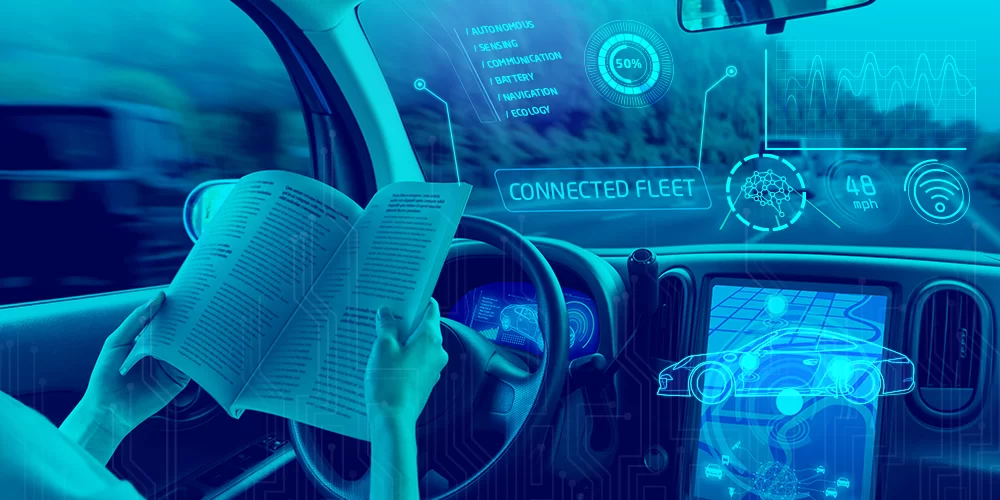Fleet Management in 2024 & Beyond: What Does the Future Look Like?

Share this blog
Perilous driving behaviour, fuel monitoring woes, and issues fetching data from telematics. It shouldn’t be surprising if, in the next decade, fleet managers have to bid goodbye to all or most of these issues. Thanks to digital transformation in the automotive industry, the commercial fleet sector is experiencing a full forced disruption. Although it is a slow-paced transition and is facing a few challenges, the future looks bright.
If you are a fleet manager who undertakes the humongous task of managing fleet, you must be aware that the role of modern fleet manager has transitioned from a tactical management style to one that requires a strategic management style. So, what are things going to look like in terms of Fleet Management in a decade from now? What should the commercial fleet sector expect? Let’s find out.
Autonomous vehicles
Fleet trucks that drive themselves to the destination. This is not a scenario far-fetched. Beyond 2024, the drivers of the fleet will no longer have to keep their focus on driving but can take up job orders, send invoices on the way, update job order notes, etc. These vehicles can have a telematics program installed which keeps an eye on traffic and advises the driver to opt for a different route.
However, before this happens, there is a dire need to craft better semi-autonomous vehicles. In today’s times, drivers control most of the features apart from functionalities like parallel parking and sensory brakes that apply themselves in case a vehicle is about to meet with an accident. Once these semi-autonomous vehicle technologies are perfected, the telematics systems would be able to gauge driver behaviour schedules and operate accordingly.
Alternative Fuels
It is estimated that by the year 2025, there will be 510 million more people in the middle economy class as compared to the number that was in the year 2015. This depicts an increase in spending abilities and employment opportunities bringing economic growth. Fortunately, or unfortunately, it also means, more vehicles on the road and more fuel consumption.
Now, looking at the catastrophe planet is going through, several world governments are about to ban petrol and diesel sale. The ban in the U.K. will come into force by the year 2040. During such times, electric cars would be the only option for your fleet. However, with batteries, the problem is, they do not have the potential to power huge vehicles over long distances. Alternative fuels like hybrid, fuel-cell, bio-fuel and liquid natural gas would be used so that the fleets can keep working efficiently.
State-of-the-Art Data Connectivity
“Sometimes, it feels like our data is held, hostage.” This is a common feeling amongst the organizations that manage the fleet. And fleet managers often feel this due to lack of data transparency arising during fleet operations. After a few years, as technology advances, fleet managers will be able to take informed fleet decisions and get over all the “what if” problems. The modern data connectivity will also provide better efficiency, reduced costs, and minimized risks.
A connected fleet of the future will sync with the telematics systems and other applications along with odometer reading and vehicle health checks. E.g. Connected vehicles of the future will be able to schedule maintenance and repair and help drivers save fuel. However, technology won’t have an upper-hand over certain third-party telematics.
And last, but not the least, a few Fleet Management Takeaways…
- In the future, even Non-IT professionals will be able to handle the fleet. The person operating it doesn’t have to belong to an automotive background.
- Cybersecurity would be one of the biggest concerns for the fleet as and when vehicle connectivity increases.
- Analysis of Big Data for finding actionable insights will become important as fleets will be connected and there will be humongous amount of data to be dealt with.
- New Mobility as a Service (MaaS) solutions like vehicle sharing, would work as alternatives for standard leasing/buying strategies.
- Vehicle rightsizing initiatives will be an area of focus for many organizations in the year 2019.
- Accident-prevention features would be commonly available and the fleet managers would use it more often for their drivers’ safety and a prolonged vehicle life-expectancy.
- OEMs will shift from Sedans to SUVs & pickup trucks, affecting the fleet portfolios.
Are you ready for the next Automotive Digital Transformation? If your answer is yes, you might want to go through Gateway Digital’s portfolio of digital automotive solutions. Drop an email to us and from there on, it is sure to be a smooth journey!
Get in Touch
Related Blogs

Dataplattform för att identifiera bilreservdelar vinner pris inom hållbarhet

Impact of Covid 19 on the Automotive Industry

How Automotive and Technology Experts See the Future of Connected Vehicles through Future Tech 5G Service

Digitalization is Upending Global Logistics

Resolving Challenges of Auto ISVs with Fruitful Technology Partnerships

Top 3 Factors Impacting Customer Satisfaction of Modern Car Buyers

Fleet Telematics Solution: Driving Great Business for Automotive Ecosystems
INDUSTRIES
PLATFORMS
SERVICES
CONSULTING
- AlvariumTM - Design Led ConsultingOpens a new window
- Digital Marketing Services
- Automotive Aftermarket
- Digital Logistics
- Remote Engineering

